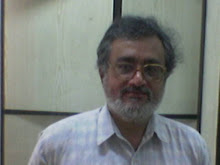Introduction: The fundamental knowledge is Atman is Brahman. The Atman being the "Self" and Brahman means the "All Soul" or the Universal Consciousness. Vedas speak of mystical union as the realization that Atman is Brahman. Advaita is a Sanskrit word that literally means "not two". Modern interpretation of Advaita is sometimes presented as "Nonduality" and even revised as the end of the Vedas or "Nonduality beyond knowledge." Another name for the study of Advaita is Jnani (knowledge) Yoga. In the 20th century, modern Advaita masters Ramana Maharshi, Nisargadatta Maharaj broke away from the traditional, scripture driven path and they spoke directly from their experience. Among the variety of reinterpretations, to find the most common understanding, I searched Encyclopædia Britannica:7th-century thinker Gaudapada, author of theMandukya-karika, argues that there is no duality; themind, awake or dreaming, moves through maya("illusion"); and only nonduality (advaita) is thefinal truth. This truth is concealed by the ignoranceof illusion. There is no becoming, either of a thingby itself or of a thing out of some other thing. Thereis ultimately no individual self or soul (jiva), onlythe atman (all-soul).The medieval Indian philosopher Sankara, (700?-750?),builds further on Gaudapada's foundation, principallyin his commentary on the Vedanta-sutras, theSari-raka-mimamsa-bhasya ("Commentary on the Study ofthe Self "). Sankara in his philosophy does not startfrom the empirical world with logical analysis but,rather, directly from the absolute (Brahman). Ifinterpreted correctly, he argues, the Upanisads teachthe nature of Brahman. In making this argument, hedevelops a complete epistemology to account for thehuman error in taking the phenomenal world for real.Fundamental for Sankara is the tenet that the Brahmanis real and the world is unreal. Any change, duality,or plurality is an illusion. The self is nothing butBrahman. Insight into this identity results inspiritual release. Brahman is outside time, space, andcausality, which are simply forms of empiricalexperience. No distinction in Brahman or from Brahmanis possible. (Encyclopædia Britannica).
Origins of Advaita (nonduality) in Vedic texts:The Self which is free from sin, free from old age, from death and from grief, from hunger and thirst, which desires nothing but what it ought to desire, and imagines nothing but what it ought to imagine, that it is which we must search out, that it is which we must try to understand. He who has searched out that Self and understands it, obtains all worlds and all desires. Chandogya Upanishad 8.7.1 All this is Brahman. Let a man meditate on that (visible world) as beginning, ending, and breathing in it (the Brahman)... Chandogya Upanishad 3.14 1, 3The separate self dissolves in the sea of pure consciousness, infinite and immortal. Separateness arises from identifying the Self with the body, which is made up of the elements; when this physical identification dissolves, there can be no more separate self. This is what I want to tell you, beloved. (Brihadaranyaka Upanishad. Chapter 2, 4:12) As the rivers flowing east and west Merge in the sea and become one with it, Forgetting they were ever separate rivers, So do all creatures lose their separateness When they merge at last into pure Being. (Chandogya Upanishad. 10:1-2) What the sages sought they have found at last. No more questions have they to ask of life. With self-will extinguished, they are at peace. Seeing the Lord of Love in all around, Serving the Lord of Love in all around, they are united with him forever. (Mundaka Upanishad. 3:2:5) ...But those who worship me with love live in me, and I come to life in them. He who knows me as his own divine Self breaks through the belief that he is the body and is not reborn as a separate creature. Such a one is united with me. Delivered from selfish attachment, fear, and anger, filled with me, surrendering themselves to me, purified in the fire of my being, many have reached the state of unity in me. (Bhagavad Gita 4:9-10) And this Self, who is pure consciousness is Brahman. He is God, all gods: the five elements - earth, air, fire, water, ether; all beings great or small, born of eggs, born from the womb, born from heat, born from soil: horses, cows, men, elephants, birds; everything that breathes, the beings that walk and the beings that walk not. The reality behind all these is Brahman who is pure consciousness. All these while they live,and after they have ceased to live, exist in him. (Aitareya Upanishad) When identified with the ego, the Self appears other than what it is. It may appear smaller than a hair's breadth. But know the Self to be infinite. (Shvetashvatara Upanishad. 5:8-9) The supreme Self is neither born nor dies. He cannot be burned, moved, pierced, cut, nor dried. Beyond all attributes, the supreme Self is the eternal witness, ever pure, indivisible, and uncompounded, far beyond the senses and the ego... He is omnipresent, beyond all thought, without action in the external world, without action in the internal world. Detached from the outer and the inner, This supreme Self purifies the impure. (Atma Upanishad. 3) Though all the galaxies emerge from him, He is without form and unconditioned. (Tejabindu Upanishad. 6) Meditate and realize this world is filled with the presence of God. (Shvetashvatara Upanishad. 1:12) You are the supreme Brahman, infinite, yet hidden in the hearts of all creatures. You pervade everything. (Shvetashvatara Upanishad. 3:7) "That in whom reside all beings and who reside in all beings, who is the giver of grace to all, the Supreme Soul of the universe, the limitless being--I am That." Amritbindu Upanishad "That which permeates all, which nothing transcends and which, like theuniversal space around us, fills everything completely from within and without, that Supreme non-dual Brahman--that thou are." Shankara


No comments:
Post a Comment